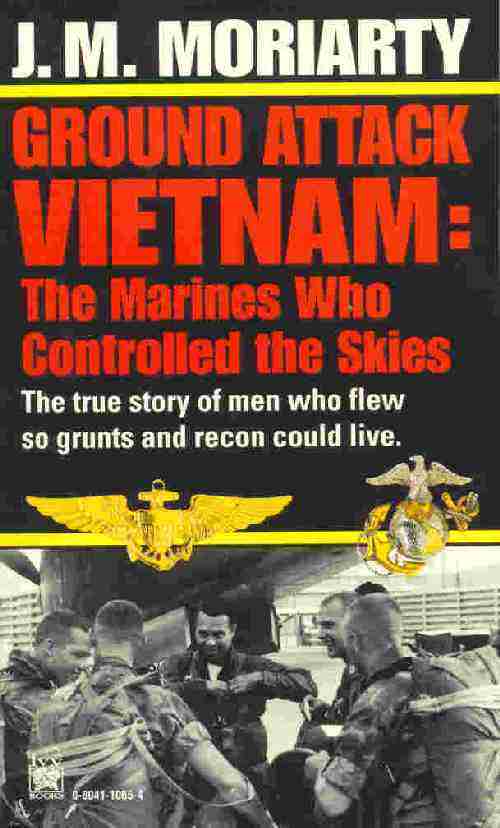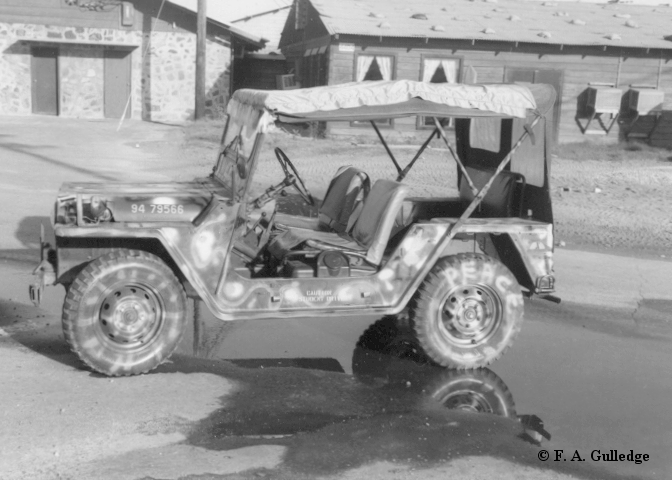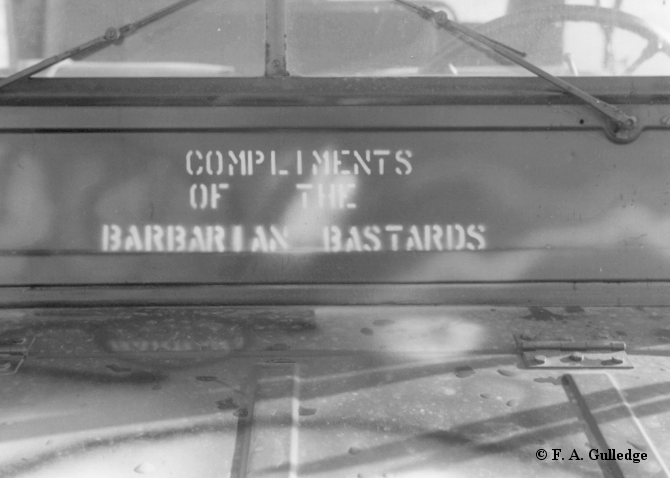The following account of some "feuding" between
The Commanding Officer of MAG-16, Col. Haywood Smith, and other Group commanders
has been taken from a book that the Webmaster of this site highly recommends.
It was written by LtCol. J. M. Moriarty, published in July 1993, Ivy Books,
Published by Ballantine Books, Copyright 1993 by Michael Moriarity.
Library of Congress Catalog Card Number: 93-91363
ISBN 0-8041-1065-4
 |
From Ground Attack Vietnam: The Marines who Controlled the Skies
In order to appreciate this, you must bear in mind that we males never grow up, we only grow older. If you keep that thought, most of what I'm about to tell you will make sense.
I want to tell you about the games people played in Vietnam. Not little games like poker and acey-deucey - - or piddling little athletic contests like softball and boxing - - not even small wars that pitted squadron against squadron and kept lieutenants busy for days, although some of those were a lot of fun. I'm talking about major conflicts between huge air groups, with separate campaigns, that brought all of the available tools of warfare into play and provided fun for the participants for weeks on end.
We Americans learn our games early in life, and virtually all of the competitive games played in Vietnam were variations on that great pastime of boarding schools and summer camps all over the world. Now, it has been said that idle hands are the Devil's workshop. The person who first said that two or three thousand years ago probably was not thinking about a group of Marines away from their families for long periods of time, but he might just as well have been. He was probably grumbling about the idle young men hanging around the forum, leering at his daughter and trying to look up her toga. But he could easily have been predicting the plight of a bunch of Marine pilots in 1970 who had too much free time on their hands.
So, let me tell you about some of the games pilots played in combat. Competitive games. Corporate games, if you are willing to compare an air group to a sizable corporation. One-upmanship does not disappear when squadrons and air groups move into the combat arena, but the means of competition grow enormously. Any time you take a group of males away from the responsibility of life and plunk them down in a summer camp environment, they're going to think up ways of entertaining themselves. And when you make available to them such marvelous toys as those which exist in combat zones, free of charge, so that the families back home will never even get a bill, then Satan is well pleased.
For most of 1970, the helicopter air group (MAG-16) was lead by Col. Haywood Smith whom we used to see on television a lot when he was President Lyndon Johnson's aide. (click here for Capt. Darracott's memory of Col .Smith) Col. Smith knew there was a difference between the helicopter community and the jet community, because of the selection priorities in the Naval Air Training Command. Most of the pilots who qualified for the more glamorous jet "pipeline" were engineers of some sort. One of the selection factors involved ground-school grades, and the students who were more proficient in math and physics had the edge. The English and history majors generally ended up flying helicopters. All of this meant that the helicopter community had a distinct advantage in the area of creative thinking, and the tightly disciplined engineers weren't too good at the subtle nuances of clever feuding. Col. Smith knew that duping aeronautical engineers was something his pilots could do best.
Consider, if you will, an episode involving the total humiliation of the jet pilots of MAG-13 based at Chu Lai. Col. Smith was bright, innovative, and very competitive, and when it came to humiliating other air groups he had no peers.
Col. Smith and some of his helicopter pilot henchmen paid a courtesy call on the F-4 Phantom pilots of MAG-13. Ostensibly, the visit was a social one in which representatives of the helicopter community were to join with the fighter pilots at Chu Lai during their Friday afternoon happy hour. But there wouldn't be any story to tell if Haywood had stuck to the script.
If you wanted to catch somebody's country by surprise and bomb its fleet out of existence, you did it on a Sunday morning. But if you wanted to destroy a Marine air group, you invaded during happy hour, when everyone who wasn't flying was in the bar drinking and singing and yelling and telling each other heroic lies.
The helicopter group's invasion party, well briefed and thoroughly trained for espionage, loaded into a huge CH-53 one Friday afternoon and flew down to Chu Lai where they were greeted warmly by the MAG-13 group commander and his staff, and transported to the officers club for an evening of camaraderie. Or rather, most of them were. Some of the helicopter pilots had more pressing chores to attend to, and remained with the helicopter under the guise of being designated drivers, backup pilots for the actual crew. They remained with the helicopter until everyone was out of sight.
Later, this raiding party borrowed a vehicle on their own, under pretenses of making a run to the mess hall. When a decent interval of time had elapsed, they too, headed for the officers club, stopping along the way only to replace a sign.
Borrowing liberally from the bravado of the Navy's replacement air group at NAS Miramar in southern California, MAG-13 had erected a self-serving sign at the entrance to their living area welcoming all to "Fighter Town." In an incredibly short period of time, indicating that the raiding party had practiced a lot, the sign was replaced by one identical in color and format. The only difference was that the new sign, in traditional Marine Corps scarlet and gold, welcomed a visitor to "Pussy Town," the adjective referring to wimpishness, of course, and not to anything carnal - which was totally lacking at Chi Lai anyway.
The new sign, ten feet by fifteen feet, with lettering fully a foot high, was not discovered until two days later, so splendid was the art work. Haywood Smith not only had balls, he also had a great paint shop. But, that clever coup was an afterthought, definitely not the highlight of the visit. Nor was the diversionary tactic of "inciting to riot" in the officers club of great importance when Haywood stood at the bar and slandered the entire air group, using a hand-held bullhorn to ensure that even the noisy lieutenants in the back were properly insulted. All of the aircraft at Chu Lai were being used as bombers, the F-4s as well as the A-4 Skyhawks, and it galled Haywood that the F-4 pilots would still call themselves fighter pilots. He announced grandly (he had worked for Lyndon, remember, and knew how it was done) that he wanted to buy a drink for every fighter pilot in the club. The cheering response to this, predictably, was boisterous, and when it subsided he slapped a one dollar bill on the bar, and added, "And I expect my change!"
Well, that got everyone's attention, as it was supposed to. The screaming and yelling and claims ad counterclaims kept everyone busy long enough for the highly skilled terrorists to accomplish their intended mission. Outside in the parking lot, the raiding party quietly stole the group commander's jeep while the helicopter pilots warmed up the CH-53 just as night descended. When the sun came up the next morning, long after the helicopter pilots had departed for home, the MAG-13 group commander finally found his jeep - on top of a hangar. He had to get the Army to retrieve it for him - and they dropped it.
That was fun, but the story I wanted to tell involved a running feud between MAG-16 at Marble Mountain and MAG-11 at Da Nang. MAG-11 was a composite group with F-4s and EA-6s belonging to the photo and electronics countermeasures squadron, and two squadrons of A-6 Intruders in addition to our OV-10s and some two-seated TA-4s. I don't recall that there was any animosity between the jet group ad the helicopter group. I think the feuding arose simply because Haywood Smith was bored, and these were the only two air groups in the immediate area.
There were about a dozen of us on the invitation list, and to save us the trouble of driving over in our jeeps, a CH-53 picked us up at the wing helicopter pad, only a few hundred yards from our living area compound.
The weather was hot but delightful, with the steady tropical ocean breeze off the South China Sea wafting across the lanai and through the rooms of the spacious beach house. We sipped our fruity rum drinks in comfortable beach chairs and were lulled into ecstasy by the roaring and hissing of the surf. I almost forgot that I was looking at the surf through the ugliest barbed-wire fence ever seen this side of Buchenwald. It was a nice day. The barbecue was hot, and the drinks were cold, and the swimming and surfing refreshing. As the sun began to set and it was time for us to go home, we loaded into jeeps for the short ride back to the flight line, where we found that the CH-53 scheduled to carry us back to Da Nang was not available, but a pair of CH-46s were.
Dutifully, we clambered aboard one of them ad took off, with the second helicopter flying escort, normal procedure for CH-46s. The Cobra gunship escort seemed unnecessary, but it gave us a feeling of security. Five minutes later, about the time we should have been landing at Da Nang, we were shaken out of our alcohol-induced reverie by the wail of warning sirens, and the helicopter began to plummet rapidly toward the darkened countryside. The crew chief yelled for us to prepare for a crash, and the plane banged down roughly in the middle of some farmer's sweet-potato patch. The copilot came back from the cockpit and told us what a close one that had been, adding that there was a backup helicopter. If we would walk three hundred yards across the field to where it had landed on a road, we'd be back home in a matter of minutes.
And, of course, as soon as everyone was halfway to the second helicopter, the pilots of both planes pulled up on the collectives and took off, stranding the group commander, his staff ad squadron commanders out in the middle of nowhere, in the dark, and without weapons. Actually, we were only about a mile outside the gates to the air base, in a very secure area abutting the heavily traveled road that connected us to 1st Marine Division headquarters. Col. Smith had arranged to have a MAG-16 six-by-six truck arrive at the scene as soon as the helicopters took off, and everyone was home safely within ann hour. But our group commander, Colonel Pommerenck, was spring-loaded to the pissed-off position just the same, and the feud began at that very moment.
Remember the selection priorities for jet pilots vs helicopter pilots? Colonel Pommerenck was a splendid air group commander, who would soon be a general, and was a marvelous human being as well. But he was, after all, an engineer, and didn't stand a chance feuding with Colonel Smith.
On Tuesday, Black Tuesday, the day of the 1st Marine Air Wing commander's weekly conference, hen Haywood Smith would drive over from Marble Mountain and park in the wing headquarters compound just as he did every Tuesday, the MAG-11 motor transport people would exact the group's revenge. Their preparatory efforts were exhaustive, and they worked into the night determining the exact amount of fuel it would take to get a jeep to the middle of Freedom Bridge that connected Da Nang to the coastal community and Marble Mountain, where the engine would sputter and die and Colonel Smith would need a tow. And, of course, the tow would come from a MAG-11 vehicle.
The plan really sucked. When Tuesday arrived and Colonel Smith left his jeep and went inside for the conference, MAG-11's people rushed the vehicle to the motor pool and drained all but the required amount of fuel from the tank. They then painted the jeep in a dozen different and bizarre colors and returned it to the wing compound, dispatching simultaneously a MAG-11 tow truck to Freedom Bridge to lie in wait.
Well, those of you who majored in English and
history know right away what happened. Haywood emerged from wing
headquarters, took one look at this jeep, . . .
 |
 |
But victorious or not, one good turn deserved another, and Haywood called his raiders into conference. This campaign was supposed to be MAG-11's retaliation, and instead MAG-16 had emerged triumphant. But upstarts had to be punished, if only to keep them in their places.
It was the paint that bothered Haywood. Painting a military vehicle in psychedelic colors simply wasn't done. MAG-11 was interested in paint, he was going to show them paint. You could see why Lyndon Johnson liked him so much and promoted him to the rank of colonel five years ahead of his counterparts.
A six-by-six truck with no discernible tactical marks on it pulled into the MAG-11 compound, showed proper paperwork to the sentries, and proceeded to the group commander's house. (The Seabees had built a house for Colonel Pommerenck, too, but in truth, it wasn't nearly as nice as the beach house.) Out tumbled a group of ten or twelve lieutenants from the helicopter group, pilots dressed in grungy coveralls, each carrying a paint bucket and brush, and a couple of them carried ladders. Within twenty minutes, they had painted the group commander's house . . . in much the same color scheme as had been used on Haywood Smith's jeep. Colonel Pommerenck was pretty put out about it all, especially the big bull's-eye painted on the roof.
The lieutenants, God bless 'em, were the willing tools who made the combat tour so much fun. These were youngsters, only two years removed from the college campuses, who had not yet been molded into the conservative, corporate mind-set of the profession, and who still remembered how to make a game out of the dreariest of situations.
Information provided by:
Ground Attack Vietnam: The Marines Who Controlled
the Skies by, J. M. Moriarty,
Published by Ballentine
Books, Copyright 1993 by Michael Moriarty, Library of
Congress Catalog Card
Number: 93-91363 and ISBN 0-8041-1065-4
John F. Darracott, Major USMC(Ret)
Franklin A. Gulledge, Jr., Major USMC(Ret)
Back Browser